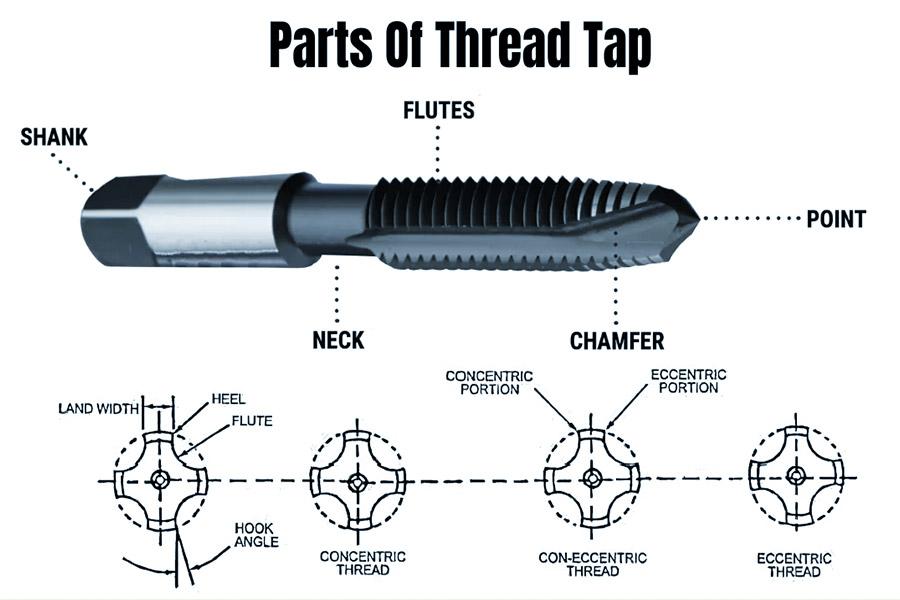Threaded connections play a crucial role in reliably joining two parts together in machine building, repair and assembly, and even in everyday DIY. And when we talk about machining precision internal threads inside the workpiece, thethread tap is the core tool. It is like a precision “carving knife”, in the metal, plastic and other materials within the hole, cutting or extruding the standard spiral groove - thread.
What is a thread tap?
A thread tap is a special cuttingor extrusion tool used to process internal threads. It cuts metal materials or extrudes metal plastic deformation by rotating in a pre-drilled bottom hole to form a high-precision, standardized thread structure, so that bolts, screws and other fasteners can be screwed in reliably and connected firmly. Its core function is toprovide efficient and stable thread forming capabilities for mechanical parts, and it is a basic tool in industrial manufacturing and maintenance.
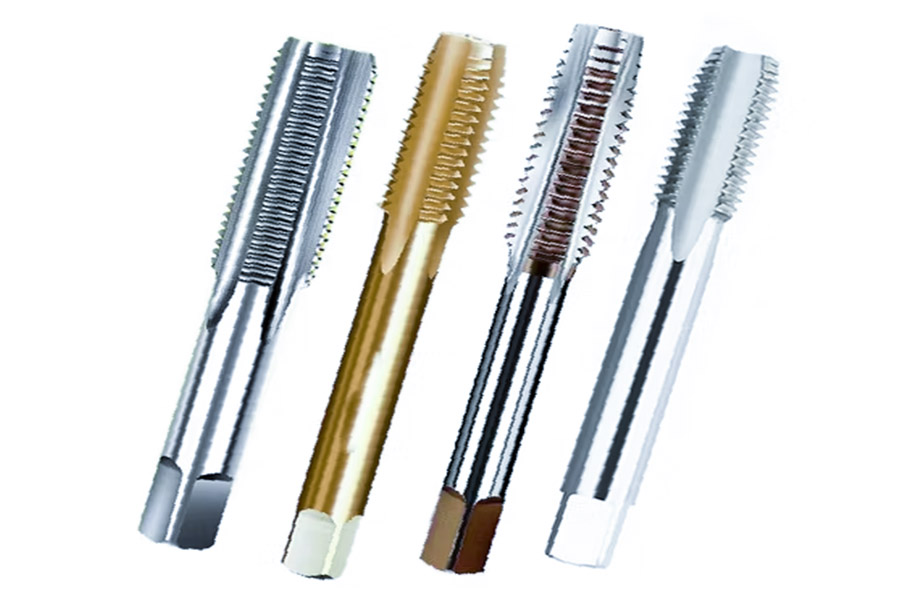
What are the types of thread taps?
Threaded taps (also known as taps) are the core tool for making internal threads in machining. According to the processing principle, structural design and application scenarios, thread taps are mainly categorized into the following major types to help users accurately match the material and working condition requirements:
1. Cutting tap (material removal type)
Principle of operation: Cutting metal to form a threaded groove through the teeth of the cutting edge.
(1) Straight Groove Tap
- Structural characteristics:axial straight groove, symmetrical cutting edge
- Advantage:strong versatility, low cost, can be repaired and sharpened
- Limitations:weak chip removal ability, easy to block chips in blind holes
- Typical applications:Mild steel through holes, threads up to M20.
(2) Spiral flute taps
- Innovative design:15°-45° helix angle (angle matched to material)
- Ferrous metals:30° helix angle balances strength and chip removal.
- Non-ferrous metals:45° large helix angle improves sharpness.
- Chip removal mechanism:Chips are directed backward along the spiral groove (key to blind hole machining)
- High-performance scenarios:deep blind holes instainless steel(depth > 3x diameter), aluminum alloy cases
(3) Screw tip tap (apex tap)
- Edge characteristics:Negative camber (-5° to -10°) design
- Chip flow:forced forward (through-hole exclusive)
- Efficiency Advantage:Allows 30% higher RPMs, reduces burrs
- Application limitations:not suitable for blind holes (chip buildup damages threads)
2. Extrusion Tap (Plastic Deformation Type)
Revolutionary principle: nocutting edge design, metal flow shaped by high pressure
(1) Structural features:
- Polygonal cross-section (triangular/quadrangular) generates radial compression force.
- No chipformer grooves, 200% increase in overall strength.
(2) Performance Advantage:
- 30% increase in thread tensile strength (cold work hardening effect)
- Surface roughnessRa ≤ 0.8 μm (mirror effect)
(3) Severe conditions:
- Bottom hole accuracy required ±0.02mm (Example: M6 bottom hole requires φ5.35±0.02)
- Only for materials with elongation >10% (e.g. 6061 aluminum alloy, H62 brass)
3. Special engineering faucets
(1) Skip tooth tap (chip breaking design)
- Anti-sticky tool technology:remove cutting teeth at intervals (1-3-5 teeth retained, 2-4-6 teeth removed)
- Torque reduction:40% reduction in contact area, solving 304 stainless steel tapping sticky knife
- Industrial validation:austeniticstainless steel machininglife increased by 3 times
(2) Tap for screw sleeve
- Precision matching:60° tooth angle (standard tap 55°)
- Bottom hole specification:5%-8% larger than normal thread (Example: M4 screw sleeve needs φ4.3 bottom hole)
(3) Composite coating tap
| Coating type | Color | Heat limit | Applicable materials |
|---|---|---|---|
| TiN | Gold color | 600℃ | General-purpose steel parts |
| TiAlN | Purple-black | 900℃ | High temperature alloy, hardened steel |
| CrN | Silver gray | 700℃ | Non-ferrous metal |
4.Classification of driving mode
(1) Hand tap set
- Combination logic:head taper (60% of cutting capacity) + second taper (40% of finishing)
- Inverted taper design:radial back angle of 0.05-0.1mm for each tooth of the second taper to prevent jamming.
(2)Machine taps
- High rigidity shank:DIN1835B type shank (with driving plane)
- Dynamic balance:G6.3 grade balance is required for speed >3000rpm.
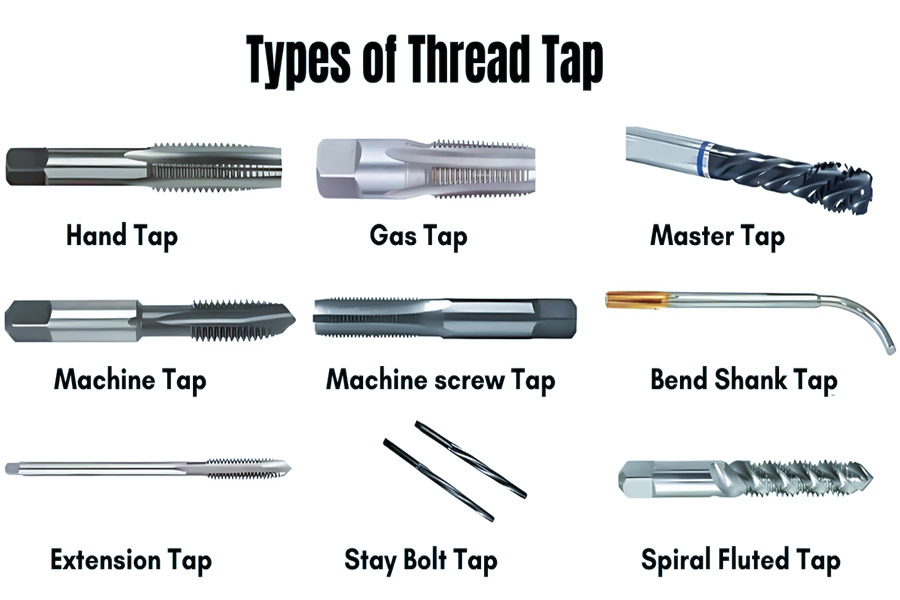
How Do Spiral Flute Taps Work?
Through the unique design of spiral groove, spiral groove taps change the vertical chip removal of traditional tapping into a constant chip guide, completely solving the problem of chip clogging in deep/blind hole machining, and improving the efficiency by 300%!
1. Core workflow (3 stages)
(1) Cutting Entry Stage
① Taper guide: the fronttapered cutting teethare the first to contact the material, and gradually cut in to form the initial contour of the thread.
② Helical edge cutting: The main cutting edge removes material along a helical path (feed per revolution = pitch).
(2) Chip control stage
① Chip generation: The metal is stripped by the cutting edge to form strip or flake chips.
② Spiral groove chip guide:
▶ Right-hand flute tapping (tapping right-hand threads): Chips are pushed forward along the spiral groove (in the direction of the bottom of the hole).
▶ Left-hand flute tap (for right-hand threads): Chips are discharged backward along the spiral groove (exit direction).
(3) Thread forming stage
① Calibration section trimming: The rear complete tooth shape trims the thread wall to ensure dimensional accuracy (up to IT7 grade).
② Continuous chip removal: Chips always move directionally along the spiral groove and out of the machining area to avoid scratching the thread.
2. Three key functions of spiral grooves
(1) Forced chip removal orientation
| Groove direction | Chip movement direction | Applicable scenarios |
|---|---|---|
| Right-hand spiral groove | → Push to the bottom of the hole | Blind hole processing |
| Left-hand spiral groove | → Exit to the hole mouth | Through hole processing |
(2) Reduction of cutting torque
① Helix angle (usually 30°-45°) breaks down the cutting force, and the axial part of the force is increased by 40%.
② Reduce the radial jitter of tap, and increase the true roundness of thread to 0.01mm.
(3) Increase chip space
Continuous spiral channel increases chip volume by 50%+ compared to straight channel.
② Avoid chip chipping caused by chip extrusion (70% reduction in taper breakage rate).
3. Comparison of actual performance (with traditional straight groove taps)
| Indicators | Spiral groove taps | Straight groove taps |
|---|---|---|
| Blind hole chip removal effect | ⭐⭐⭐⭐⭐ (no blockage) | ⭐⭐ (frequent chip blockage) |
| Thread surface roughness | Ra 0.8-1.6μm | Ra 1.6-3.2μm |
| Cutting torque | Reduced by 25%-30% | Standard value |
| Applicable hole depth/diameter ratio | ≤3:1 | ≤1:1 |
▶ Golden formula for user selection
Direction of spiral groove = Thread direction × Hole pattern factor
Case 1:Machining a right-hand threaded blind hole → Select a right-hand spiral flute tap (chips are pushed to the bottom of the hole).
Case 2:Machining a right-hand threaded through-hole → choose a left-handed helical flute tap (chips are pushed out of the hole).
Engineer's Tip:
Whenmachining titanium/stainless steel, use a large helix angle (45°+) to enhance chip flow!
Wrong choice of flute direction will lead to chip blockage → thread rot → tap breakage (90% of failures).
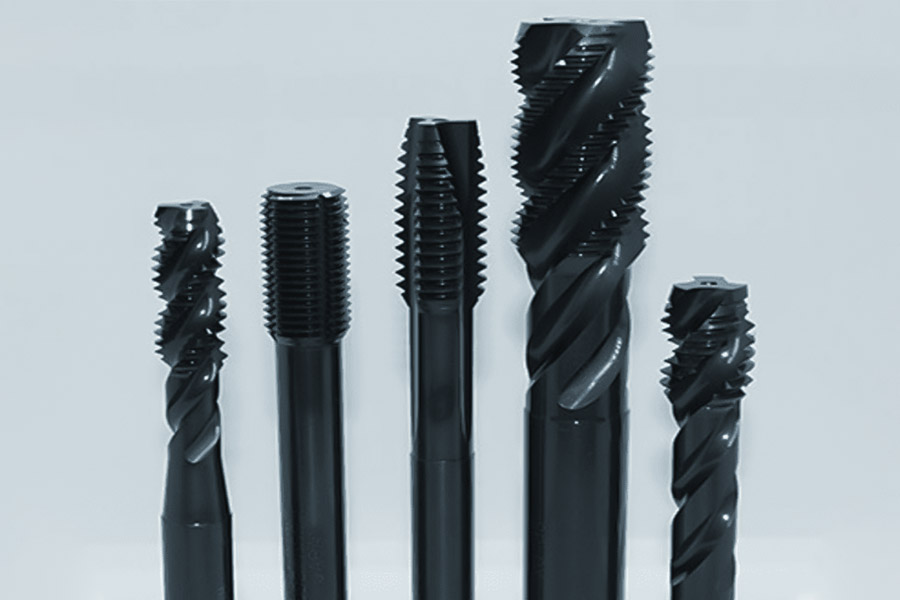
What materials are thread taps made of?
80% of the durability of thread taps depends on the material! From general high-speed steel to cutting-edge carbide, the evolution of materials has enabled taps to cut hardened steel (HRC60+), increasing their lifespan by 10 times.LS reveals the logic behind its mainstream materialand coating technology selection.
1. Base material: 3 core types
(1)High-speed steel (HSS)|King of cost performance
① Ingredient:
Tungsten system (W18Cr4V): Containing 18% tungsten, high wear resistance, suitable for stainless steel/cast iron.
Molybdenum (M2/M35): Containing 5-10% molybdenum, with 30% higher toughness and superior chip resistance.
② Performance:
Hardness: HRC 63-67
Heat resistance: maintain hardness below 600°C
Cost: only 1/5 of cemented carbide
③ Scenario:
General-purpose steel,aluminum alloys, plastics (70% market share)
(2) Cemented carbide (Carbide)|Peak of wear resistance
① Ingredient:
WC (tungsten carbide) particles + Co (cobalt) bonding phase (Co content 6-15%, the higher the toughness, the stronger).
② Performance:
Hardness: HRA 90-94 (≈HRC 80+)
Wear resistance: 5-8 times the high-speed steel
Compressive strength: 3500 MPa
③ Scenario:
Hardened steel (HRC 45+), titanium alloys, high temperature alloys, glass fiber reinforced plastics
(3) Powder Metallurgy High Speed Steel (PM-HSS)|Balanced Choice
① Process:
Atomized powder making → hot isostatic pressing molding, 300% improvement in carbide distribution uniformity.
② Advantage:
Toughness is 40% higher than conventional HSS, and wear resistance is increased by 50%.
Suitable for the manufacture of complex grooves (such as large spiral angle taps).
③ Scenario:
Stainless steel (304/316),high-alloy steel batch processing.
2. Surface Coating: 4 Major Strengthening Technologies
(1) Titanium Nitride (TiN)|Classic Golden Armor
① Thickness: 1-3 μm
② Characteristics:
Hardness HV 2300, coefficient of friction 35% lower
Heat resistance: 600°C
③Application: general-purpose steel parts, aluminum alloy
(2)Titanium Carbide Nitride (TiCN)|Violet Warrior
① Thickness: 2-5 μm
② Characteristics:
Hardness HV 3000↑, wear resistance increased by 50% compared with TiN.
Excellent chip resistance
Application: Stainless steel, alloy steel
(3)Titanium Aluminum Nitride (TiAlN)|King of Red Hardness
① Thickness: 1-4 μm
② Characteristics
Heat resistance: 900°C (Al₂O₃ protective film generated at high temperature)
Oxidation resistance increased by 3 times
③ Application:titanium alloy, hardened steel, high-speed dry cutting
(4) Diamond Coating (DLC)|Non-ferrous Metal Specialist
① Thickness: 0.5-2 μm
② Characteristics:
Friction coefficient ≤ 0.1 (self-lubricating)
Resistance to aluminum chip adhesion increased by 90%.
③Application: silicon aluminum alloy, copper alloy, graphite.
▶ Material performance comparison table (key index quick check)
| Material type | Hardness | Wear resistance index | Toughness index | Cost index | Best scenario |
|---|---|---|---|---|---|
| High-speed steel (HSS) | HRC 63-67 | 1.0× | ★★★★ | $ | General metal/small batch |
| PM-HSS | HRC 66-68 | 1.5× | ★★★☆ | $$ | Stainless steel/mass production |
| Carbide | HRA 90-94 | 5.0-8.0× | ★★☆ | $$$$ | Hardened steel/titanium alloy |
| Carbide+TiAlN | HRA 92+coating | 10.0×↑ | ★★☆ | $$$$$ | High-temperature alloy/high-speed dry cutting |
3. Golden rule of selection (matching materials and working conditions)
(1) Selection of substrate by workpiece material
① Aluminum/copper alloy → HSS + DLC coating (anti-bonding)
② Stainless steel → PM-HSS + TiCN coating (anti-wear and anti-stick)
③ Hardened steel (>HRC45) → Cemented carbide + TiAlN coating
(2) Selection of coating according to processing conditions
① Sufficient lubrication → TiN/TiCN (best cost performance)
② Minimal lubrication/dry cutting → TiAlN (high temperature oxidation resistance)
③ High surface quality → DLC (mirror-grade finish)
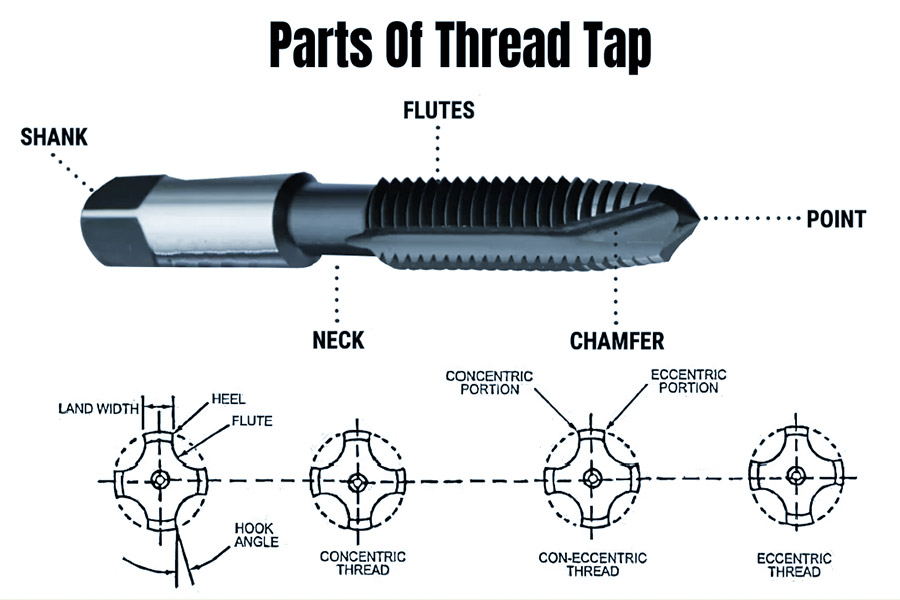
How do I choose the right thread tap for the job?
Thebelowis a systematic decision-makingflow to thread taps on6criticaldimensions,complemented bya scenario-based selection table toleadyoutoaccurately match your needs:
6-stepthread tap selection process
1. Determine hole characteristics
| Hole type | Recommended tap type | Key reason |
|---|---|---|
| Through hole | Spiral point tap/left-hand spiral groove tap | Chips are automatically discharged downward to avoid clogging |
| Blind hole | Right-hand spiral groove tap | Chips are pushed forward (bottom of hole) to protect the thread |
| Deep hole (depth-to-diameter ratio>3) | Large helix angle (45°+) tap |
Enhance chip removal ability and reduce the risk of tap breakage
|
2. Analyze the workpiece material
| Material type | Substrate material | Coating selection | Special requirements |
|---|---|---|---|
| Aluminum alloy/copper alloy | HSS or PM-HSS | DLC diamond coating | Anti-adhesion, large rake angle (15°+) required |
| Stainless steel | PM-HSS | TiCN/TiAlN | High temperature resistance, spiral groove chip removal optimization |
| Hardened steel (>HRC45) | Cemented carbide | TiAlN | Low speed cutting (≤5m/min) |
| Cast iron | HSS (containing cobalt) | TiN | Straight groove design to avoid chipping |
| Titanium alloy/high temperature alloy | Cemented carbide + micro grain | TiAlN/AlCrN | Very low speed (≤3m/min), sufficient cooling |
- Small batch/repair: hand tap set (cost savingand flexible)
- Medium batch: machine straight groove/spiral groove tap
- Automated production line:
Through hole → spiral tip tap (drilling+ tappingin onepass)
Blind hole → powder metallurgy HSS spiral groove tap (lifeincreased by 50%)
4.Categoricallymatch thread standards
| Thread type | Special tap | Tooth profile |
|---|---|---|
| Metric thread (M) | Machine cutting tap | 60° tooth angle, sharp tooth top |
| American standard thread (UN) | Unified thread tap | 60° tooth angle, flat tooth top |
| Pipe thread (NPT) | Tapered pipe thread tap | 1:16 taper, 55° tooth angle |
| British standard (BSPT) | 55° taper pipe tap | 1:16 taper, round tooth top |
5.Cost consideration
Cost effectiveness index = (price per tap × life expectancy) ÷ number of holes to be machined
Comparison of cases:
High-speed steel tap: unit price¥ 30,machining300 holes → cost ¥ 0.1 / hole
Carbide taps: unit price ¥ 300,machining5000 holes → cost ¥ 0.06 / hole
Conclusion: batchmachiningof hardmaterial, cemented carbide lowertotalcosts
6.Evaluationof work condition suitability
Machining conditions Optimization
LesscoolingUtilizationof TiAlN coated taps (800°C high temperature resistance)
Micro lubrication (MQL) Extruded taps (no chips,nooil mist clogging)
High accuracyrequires Lengthytap with calibrationsegment(IT6 accuracy)
Discussionofinappropriate choice situations(Guide tothe avoidance ofpitfalls)
| Failure phenomenon | Root cause | Correct selection |
|---|---|---|
| Broken taper due to chip accumulation at the bottom of blind hole | Misuse of straight groove tap | Switch to right-hand spiral groove tap |
| Stainless steel thread surface roughening | Uncoated tap + insufficient lubrication | PM-HSS + TiCN coating + tapping oil |
| Aluminum alloy thread adhesion | Ordinary HSS tap without anti-sticking coating | HSS + DLC coating, rake angle increased to 20° |
Ultimate selection quick reference table
| Scenario | Preferred tap | Parameter reinforcement |
|---|---|---|
| Automobile cylinder aluminum blind hole | Right-hand spiral groove tap + DLC coating | Helix angle 45°, bottom hole enlargement 0.05mm |
| 304 stainless steel flange through hole | Left-hand spiral groove TiCN coated tap | Speed 15m/min, emulsion cooling |
| Mold insert hardened steel (HRC50) hole | Carbide TiAlN coated tap | Speed 3m/min, oil-based coolant |
| Hydraulic valve block NPT thread | Carbide taper pipe thread tap | Taper hole before tapping to ensure sealing surface |
Core formula:
Successful selection = hole type × material × precision × cost
If any dimension islacking, efficiency and life will be reduced by 50%+!
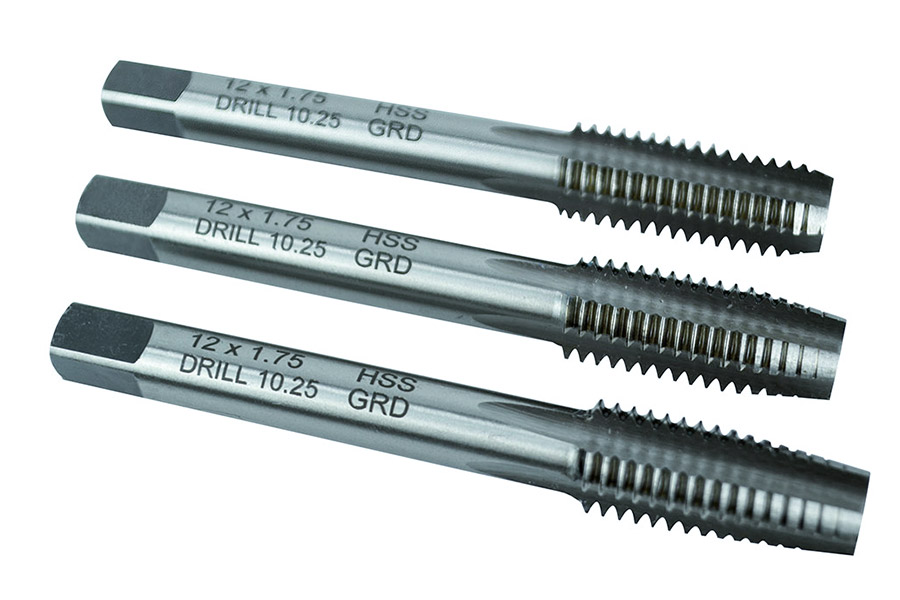
Why do thread taps breakinuse?
Thebelowis amechanisticclassification of the causesforthread tap breakage and a summary ofthesolutions and distillsthekey onmechanics and industrial data:
| Reason for breakage | Occurrence mechanism | Percentage | Typical characteristics | Solution |
|---|---|---|---|---|
| 1. Wrong bottom hole diameter | The hole diameter is too small → cutting torque is overloaded; The hole diameter is too large → the tap runs out radially |
35% | The tap root is twisted off or the edge is broken | Calculate the bottom hole according to the material: Stainless steel: thread major diameter - pitch + 0.1mm Aluminum alloy: thread major diameter - pitch + 0.15mm |
| 2. Chip blockage | Chip accumulation in blind hole → chip groove is completely blocked → torque increases sharply | 25% | The groove is filled with metal chips, and the fracture is torn |
Use right-hand spiral groove taps for blind holes |
| 3. Concentricity deviation | The tap axis and bottom hole offset ≥0.1mm → withstand bending stress | 15% | Fracture tilt, threaded hole elliptical deformation | Floating tapping chuck for machine tapping Add guide bushing for hand tapping |
| 4. Abnormal material hardness | Hard point of workpiece (HRC50+) → Local cutting force sudden change | 10% | Cutting edge collapse and fracture | Hardness test before processing Switch to carbide tap and reduce speed by 50% |
| 5. Cooling failure | Dry cutting → Temperature>800℃→Cutting edge annealing and sticking | 8% | Fracture bluish, adhered to workpiece material | Extreme pressure cutting oil for stainless steel Flow rate ≥5L/min |
| 6. Parameters are incorrectly set | Speed is too high → built-up edge wrapping; Feed is not synchronized → tensile stress |
5% | There is a material weld layer on the tap surface | Calculate according to the formula: Speed N=(Vc×1000)/(π×D) Carbon steel Vc=10-15m/min |
| 7. Excessive wear of the tap | Back tool wear>0.2mm→cutting force increases by 30% | 2% | The thread surface is rough and there are fatigue marks on the fracture | Establish life monitoring Wear reaches 0.15mm and must be replaced |
| 8. Insufficient rigidity of the fixture | Clamping slips → square head twisting and cracking; Vibration → stress concentration |
- | Square head deformation or fracture | Use spring chuck for M8 and below Use hydraulic chuck for M8 and above |
Summary
Though small,threaded taps are an indispensable and fundamental toolin modern manufacturing and maintenance. From precision aerospace parts to everyday furniture assembly, its contribution is indispensable. Understanding its working principle, type characteristics, selection of key points and the correct operation method, not only can efficiently process a high-quality internal thread, to ensure the reliability and safety of the connection, but also significantly enhance the efficiency and extend the service life of the tool. The next time you use a tap, you may wish to experience more of this precision “carving knife” in the metal to create a spiral miracle process.
📞 Phone: +86 185 6675 9667
📧 Email: info@longshengmfg.com
🌐 Website:https://lsrpf.com/
Disclaimer
The content of this page is for informational purposes only.LS SeriesNo representations or warranties of any kind, express or implied, are made as to the accuracy,completeness or validity of the information. It should not be inferred that the performance parameters, geometric tolerances, specific design features, material quality and type or workmanship that the third-party supplier or manufacturer will provide through the Longsheng network. This is the responsibility of the buyerAsk for a quote for partsto determine the specific requirements for these parts.please Contact us Learn more information.
LS Team
LS is an industry-leading companyFocus on custom manufacturing solutions. With over 20 years of experience serving more than 5,000 customers, we focus on high precisionCNC machining,Sheet metal fabrication,3D printing,Injection molding,metal stamping,and other one-stop manufacturing services.
Our factory is equipped with more than 100 state-of-the-art 5-axis machining centers and is ISO 9001:2015 certified. We provide fast,efficient and high-quality manufacturing solutions to customers in more than 150 countries around the world. Whether it's low-volume production or mass customization,we can meet your needs with the fastest delivery within 24 hours. chooseLS TechnologyIt means choosing efficiency, quality and professionalism.
To learn more, please visit our website:www.lsrpf.com

FAQs
1. What is the core function of a thread tap?
A thread tap is a cutting or extrusion toolspecifically used to process standardized internal threads in pre-drilled holes (bottom holes). It cuts into the workpiece material (such as metal, plastic) through rotational motion, accurately forming a continuous spiral groove structure (such as metric M thread, American standard UN thread, etc.), so that the hole wall can fit tightly with external threaded parts such as bolts and screws, and achieve reliable fastening and sealing between parts. It is an indispensable basic process tool in mechanical assembly.
2. How does a thread tap work?
When athread tap is working, its front tapered cutting edge first cuts into the bottom hole wall. As it rotates and feeds, the sharp cutting edge continuously removes the material (cutting tap) or plastically deforms the extruded material (extrusion tap), forming a thread profile that meets the target specifications. The debris generated by cutting is discharged out of the hole through the straight groove or spiral groove on the surface of the tap, and the calibration teeth at the rear refine the thread to ensure dimensional accuracy (up to IT7 level) and surface finish (Ra 0.8-3.2μm), and finally generate a complete internal thread structure in the hole.
3.Why can't ordinary drills be used to directly process threads?
Ordinary drills can only process cylindrical holesand cannot generate spiral grooves with specific tooth angles (such as 60° metric threads), pitches, and depth-to-diameter ratios. The teeth of thread taps are designed with precise geometric profiles (such as rake angle, back angle, and chip grooves) to control chip morphology and withstand tapping torque. If a drill is used to "tap" forcibly, the thread tooth profile will be distorted, the size will be out of tolerance, and even the tool will break. The special structure of the tap makes it the only practical tool for efficiently generating standardized threads.
4. What are the key factors to consider when selecting a thread tap?
Selecting a thread tap requires comprehensive consideration of four core dimensions: First, based on the hole characteristics - through holes are preferably selected with spiral tip taps or left-hand spiral groove taps to achieve downward chip removal, while blind holes must use right-hand spiral groove taps to push the chips forward; secondly, analyze the workpiece material, plastic materials such as aluminum alloy/copper are suitable for extrusion taps, andhardened steel or titanium alloys need to match carbide coated taps; at the same time, confirm the thread standard, metric/American standard general taps can meet conventional needs, while NPT and other sealed pipe threads must use special taper taps;Finally, considering the processing conditions, machine taps are used for mass production to improve efficiency, while hand taps are used for maintenance to facilitate operation. Accurately matching these factors can avoid tap breakage and tooth decay, improve efficiency by 300% and significantly extend tool life.


